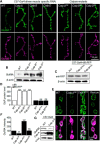Calcium-Activated Calpain Specifically Cleaves Glutamate Receptor IIA But Not IIB at the Drosophila Neuromuscular Junction
- PMID: 30705102
- PMCID: PMC6462441
- DOI: 10.1523/JNEUROSCI.2213-17.2019
Calcium-Activated Calpain Specifically Cleaves Glutamate Receptor IIA But Not IIB at the Drosophila Neuromuscular Junction
Abstract
Calpains are calcium-dependent, cytosolic proteinases active at neutral pH. They do not degrade but cleave substrates at limited sites. Calpains are implicated in various pathologies, such as ischemia, injuries, muscular dystrophy, and neurodegeneration. Despite so, the physiological function of calpains remains to be clearly defined. Using the neuromuscular junction of Drosophila of both sexes as a model, we performed RNAi screening and uncovered that calpains negatively regulated protein levels of the glutamate receptor GluRIIA but not GluRIIB. We then showed that calpains enrich at the postsynaptic area, and the calcium-dependent activation of calpains induced cleavage of GluRIIA at Q788 of its C terminus. Further genetic and biochemical experiments revealed that different calpains genetically and physically interact to form a protein complex. The protein complex was required for the proteinase activation to downregulate GluRIIA. Our data provide a novel insight into the mechanisms by which different calpains act together as a complex to specifically control GluRIIA levels and consequently synaptic function.SIGNIFICANCE STATEMENT Calpain has been implicated in neural insults and neurodegeneration. However, the physiological function of calpains in the nervous system remains to be defined. Here, we show that calpain enriches at the postsynaptic area and negatively and specifically regulates GluRIIA, but not IIB, level during development. Calcium-dependent activation of calpain cleaves GluRIIA at Q788 of its C terminus. Different calpains constitute an active protease complex to cleave its target. This study reveals a critical role of calpains during development to specifically cleave GluRIIA at synapses and consequently regulate synaptic function.
Keywords: Drosophila neuromuscular junction; GluR; calcium; calpain; cytoplasmic cysteine protease; glutamate receptor.
Copyright © 2019 the authors.
Figures










Similar articles
-
Ttm50 facilitates calpain activation by anchoring it to calcium stores and increasing its sensitivity to calcium.Cell Res. 2021 Apr;31(4):433-449. doi: 10.1038/s41422-020-0388-4. Epub 2020 Aug 26. Cell Res. 2021. PMID: 32848200 Free PMC article.
-
Versatile Endogenous Editing of GluRIIA in Drosophila melanogaster.Cells. 2024 Feb 10;13(4):323. doi: 10.3390/cells13040323. Cells. 2024. PMID: 38391936 Free PMC article.
-
Dbo/Henji Modulates Synaptic dPAK to Gate Glutamate Receptor Abundance and Postsynaptic Response.PLoS Genet. 2016 Oct 13;12(10):e1006362. doi: 10.1371/journal.pgen.1006362. eCollection 2016 Oct. PLoS Genet. 2016. PMID: 27736876 Free PMC article.
-
The calcium-dependent protease calpain in neuronal remodeling and neurodegeneration.Trends Neurosci. 2021 Sep;44(9):741-752. doi: 10.1016/j.tins.2021.07.003. Epub 2021 Aug 17. Trends Neurosci. 2021. PMID: 34417060 Review.
-
[The physiological and pathological function of Ca(2 +) -dependent cysteine protease (Calpain) ].Clin Calcium. 2013 Apr;23(4):519-25. Clin Calcium. 2013. PMID: 23545741 Review. Japanese.
Cited by
-
Ttm50 facilitates calpain activation by anchoring it to calcium stores and increasing its sensitivity to calcium.Cell Res. 2021 Apr;31(4):433-449. doi: 10.1038/s41422-020-0388-4. Epub 2020 Aug 26. Cell Res. 2021. PMID: 32848200 Free PMC article.
-
The auxiliary glutamate receptor subunit dSol-1 promotes presynaptic neurotransmitter release and homeostatic potentiation.Proc Natl Acad Sci U S A. 2020 Oct 13;117(41):25830-25839. doi: 10.1073/pnas.1915464117. Epub 2020 Sep 24. Proc Natl Acad Sci U S A. 2020. PMID: 32973097 Free PMC article.
-
Postsynaptic cAMP signalling regulates the antagonistic balance of Drosophila glutamate receptor subtypes.Development. 2020 Dec 16;147(24):dev191874. doi: 10.1242/dev.191874. Development. 2020. PMID: 33234716 Free PMC article.
-
Sympathetic innervation in skeletal muscle and its role at the neuromuscular junction.J Muscle Res Cell Motil. 2024 Jun;45(2):79-86. doi: 10.1007/s10974-024-09665-9. Epub 2024 Feb 17. J Muscle Res Cell Motil. 2024. PMID: 38367152 Free PMC article. Review.
-
A comparison of three different methods of eliciting rapid activity-dependent synaptic plasticity at the Drosophila NMJ.PLoS One. 2021 Nov 30;16(11):e0260553. doi: 10.1371/journal.pone.0260553. eCollection 2021. PLoS One. 2021. PMID: 34847197 Free PMC article.
References
Publication types
MeSH terms
Substances
LinkOut - more resources
Full Text Sources
Molecular Biology Databases
